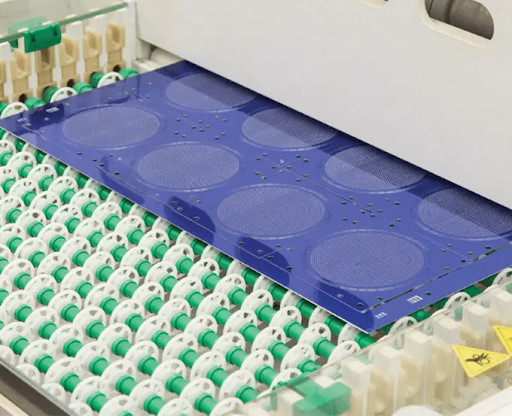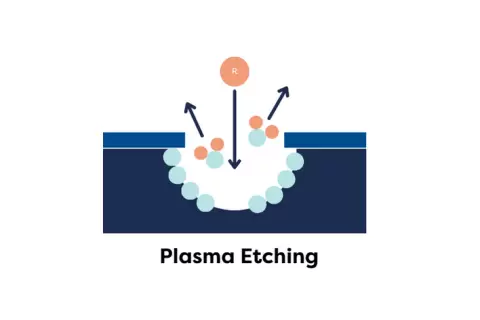In manufacturing, we use etching to remove material from the surface to create the desired patterns or shapes. Chemical and plasma etching are two methods of etching. In chemical etching, liquids such as acids are used for the controlled removal of material. Plasma etching has energized gas that acts like little hammers that remove the material layer by layer. Both methods can produce very fine-detail patterns, but these are very different processes at very different prices.
In this article, we’ll compare different factors between chemical etching vs plasma etching. Continue reading to know about the mechanism and cost of both methods.
Chemical Etching
As the name suggests, chemical etching uses liquid chemicals to remove material from surfaces in a controlled fashion. The chemical etching process depends on a chemical reaction that dissolves certain materials while leaving other materials intact. Here are some main uses of photochemical etching:
- Printed circuit boards (PCBs)
- Metal nameplates and labels
- Precision metal parts
- Decorative patterns
- Microfluidic devices
Advantages of chemical etching

Chemical etching has a number of advantages that make it a popular method of manufacturing.
- The process is relatively uncomplicated and does not require any complex machinery.
- In comparison to other methods, the equipment costs are relatively low
- Can etch large areas at the same time
- Produces smooth edges, without burrs
- Can handle complex shapes easily
- Good for thin materials
Disadvantages of chemical etching
While chemical etching comes with many benefits, it has several disadvantages as well, which preclude its use for many applications.
- Significantly slower than plasma etching
- Creates chemical waste, which can be costly to dispose of
- Requires sufficient ventilation
- Safety equipment is required
Why Choose TMNetch for Your Chemical Etching Needs

TMNetch is one of the leading photochemical etching companies in China, and they have over ten years of experience. Here’s what separates them from the other chemical etching companies.
- Rapid Prototyping and Production: If your requirements are technically feasible, TMNetch can produce your prototype within 6 hours and the final product in 3 days.
- Integration of Industry and Trade: Their expertise with import and export means they know how to deal with importation and deliver freight properly, and prepare the documentation for customs clearance. This means you don’t have to worry about the export of your product.
- Manufacturing Facilities: They have a large warehouse with all the raw materials from 0.01mm to 2.0 mm thickness, ready to go. TMNetch has 4 fully automatic etching machines, each 20 meters long, with 19 other supporting machines. Their state-of-the-art equipment and (raw material on hand) can give you a quicker turnaround.
Visit TMNetch and discuss your project requirements today.
Plasma Etching

Plasma etching is the process of using energized gas to remove material from surfaces. Plasma etching is created when energy is applied to gas molecules to excite them to a higher energy state. This creates highly reactive atoms and ions that bombard the material surface.
Commonly used gases for plasma etching include Oxygen, Chlorine, Argon, and Fluorine-based chemistry.
Advantages of Plasma Etching
Plasma etching provides better control and precision and operates quickly, and can work with materials that liquid chemicals cannot touch.
- No liquid chemicals necessary
- Can be used with nearly any material
- Faster processing speeds
- Superior edge quality
Disadvantages of Plasma Etching
Some disadvantages of plasma etching include:
Expensive vacuum equipment
- Higher operating costs
- Complex operating setup
- Requires trained operations
Chemical Etching vs Plasma Etching: A Comparison
When deciding between chemical etching vs plasma etching, there are several considerations that will help evaluate the most appropriate method for your project.
Cost and Complexity
- Chemical Etching: In chemical etching vs plasma etching cost comparison, chemical etching uses simple equipment such as tanks and heating systems. The upfront cost of the equipment stays low, while the costs of operation include the expensive chemicals used and the cost of waste disposal.
- Plasma Etching: Uses a vacuum system and complex electronic packages. The initial setup costs are much greater than chemical etching. The operating costs include electricity, gas, and maintenance. This process requires skilled technicians to operate the equipment correctly.
Versatility
- Chemical Etching: Works well for metals and some ceramics, but is limited to the chemical character of the material. It is best on a larger area and a simpler shape, but it cannot etch all materials.
- Plasma Etching: Capable of etching virtually any material from metals, ceramics, polymers, and composites, including complex 3D structure(s), small features, or when no tolerances are required. Plasma etching has more opportunities for applications.
Environmental Impact
- Chemical Etching: Generates liquid waste that requires proper disposal. Uses hazardous acids and chemicals, requires ventilation systems. Chemical waste treatment adds costs and complexity.
- Plasma Etching: Generally generates some sort of waste, mostly harmless gases. The plasma etching process is generally more beneficial to the environment. Electricity is the key form of input vs chemical waste. Although there may still be proper procedures for gas handling.
Material Compatibility
- Chemical Etching: Limited to the materials that are reactive with the chemicals available. Great for etching copper with good results on steel, aluminum, as well. Poor results from ceramics and some advanced materials. Resistance to chemicals determines what can be etched.
- Plasma Etching: Virtually able to etch all materials. Handle semiconductors, metals, ceramics, and polymers the same way; no chemical compatibility issues. It can even etch materials that resist chemicals from attack.
It ultimately depends on your circumstances or needs when deciding whether to use chemical etching vs plasma etching. Is it a matter of budget, materials, or process?
Chemical Etching vs Plasma Etching: Which is better?
Neither chemical etching vs plasma etching is universally better; they are effective for different types of applications. Chemical etching is best for simple metal parts, replication of large areas, and cheaper applications. Plasma etching is better for precision applications, the need to deal with complex materials, and when environmental concerns are present.
When selecting one option over the other, you should consider what material you will be working with, precision, any budget limitations, and the production run. Take each criterion into consideration when it comes time to select between chemical etching vs plasma etching.
FAQs About Chemical Etching vs Plasma Etching
Can chemical and plasma etching be combined?
Yes, there are hybrid processes that use both methods together. In the hybrid processes, chemical etching is used to remove the bulk material, and then plasma etching is used to finish the part and provide a more desirable result.
How do chemical vs plasma etching compare in material thickness?
Chemical etching can handle much thicker materials, with chemical etching operating effectively up to 3mm, while plasma etching is better with thinner layers and does best with layers that are less than 1mm, especially if you need to be very precise.
Which method is preferred based on the application’s needs?
Electronics applications prefer plasma etching and the precision it provides. Metal fabrication accepts and will usually use chemical etching due to cost. Medical devices or implants usually need plasma etching to process multiple complicated materials.
Which is more cost-effective, chemical vs plasma etching?
Chemical etching is much cheaper, normally with very simple parts and high demand quantity. Plasma etching costs more primarily because of the equipment and process; chemical etching is more cost-effective when there are many materials and they are complicated and require higher precision.
Conclusion
Both chemical etching and plasma etching are important in the manufacturing process today. Deciding which method to choose depends on factors of materials, precision required, price, and volume produced. If you understand the different purposes both types of etching serve, you can pick the correct method to get a successful project.
TMNetch provides fast prototypes and quality results. Their experienced team manages the project from design to delivery. Visit TMNetch to discuss your project requirements and get a competitive quote for your next project.
